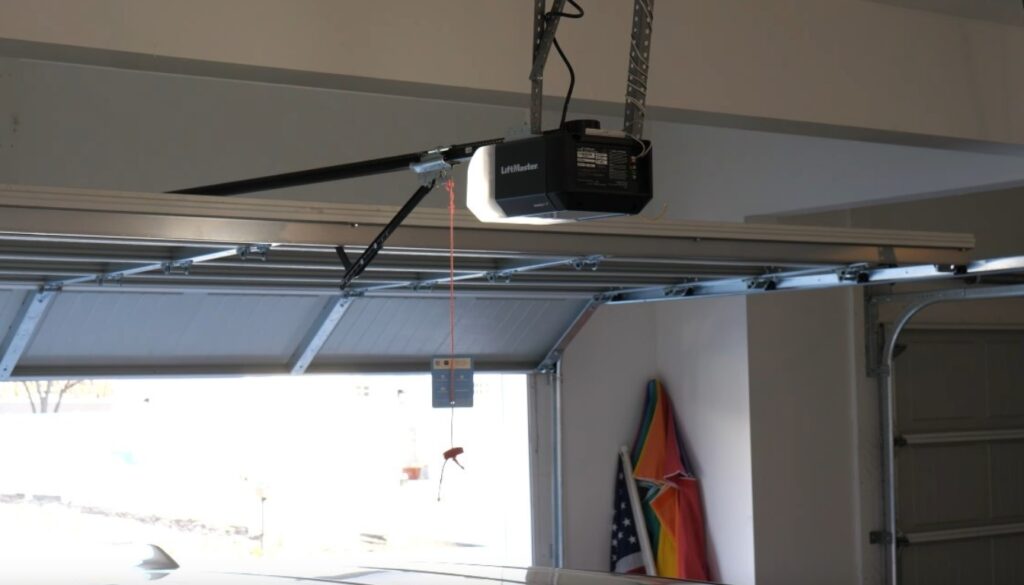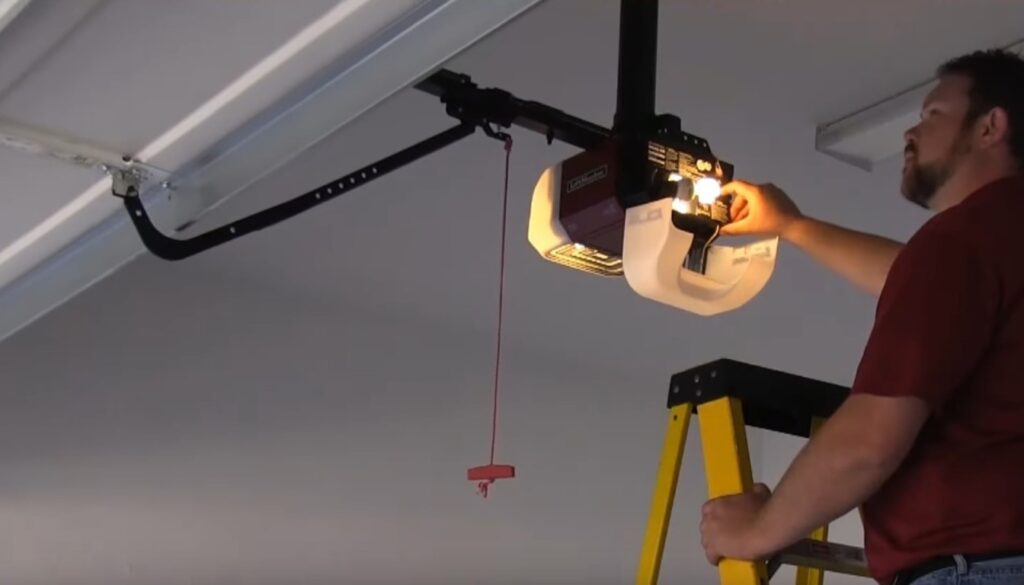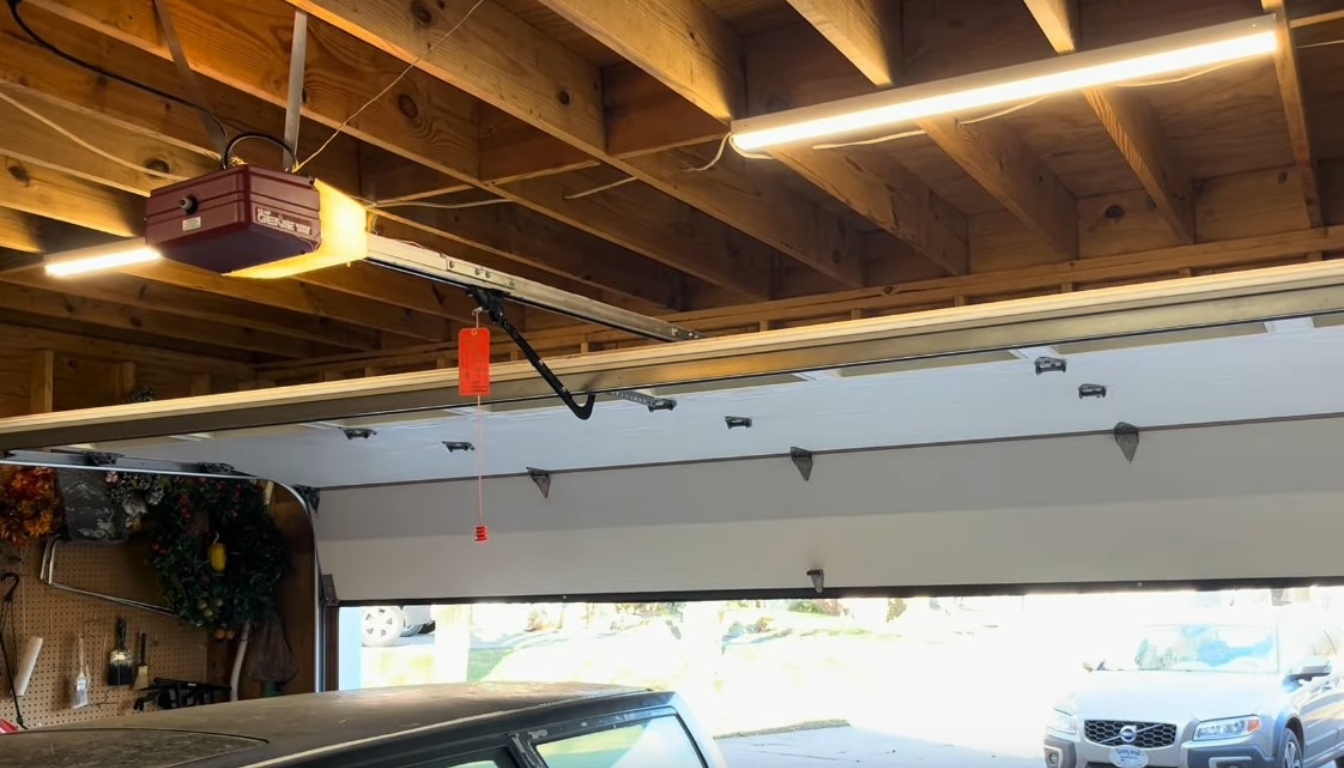Is your garage door opener acting up? Garage door openers use motors and remote controls to operate doors smoothly. This article will explain how they work and help you troubleshoot common issues. When troubleshooting common issues with your garage door system, it’s crucial to check for any obstructions in the path of the garage door opener, ensure the sensors are properly aligned, and inspect the condition of the opener’s motor and drive mechanism.
Get ready for a simple yet informative guide!
Key Takeaways
- Garage door openers use motors, remote controls, and safety features to smoothly lift and lower doors.
- The drive unit moves the door along a horizontal track using chains, belts, or screws.
- Photo eyes detect obstacles to ensure safety by stopping and reversing the door if needed.
- Common issues include dead remote batteries, blocked signals, lock button activation, and partial closures due to obstructions.
What is a Garage Door Opener?
A garage door opener is a motorized device that opens and closes your garage door. It uses wall switches or remote controls for activation. Invented by C.G. Johnson in 1926, these devices became widely used after Alliance Manufacturing Co. Introduced the remote control in 1954.
Modern openers feature safety sensors to stop the door if something is underneath it. They also include emergency release ropes for manual operation during power outages. Global sales of these openers exceeded $1 billion in 2021, highlighting their importance in daily convenience and security systems. Learn about the benefits of upgrading to a high-performance garage door opener such as the SecuraLift for smoother and quieter operation.
The Anatomy of a Garage Door Opener
A garage openers has many parts working together. These parts help lift and lower the heavy door smoothly.
Opener Remote
Opener remotes use a radio transmission system. The transmitter in the remote sends a code to the receiver inside the garage door opener. Modern roller door opener have rolling codes for better security, changing the code each time you press the remote button.
Wireless openers date back to around 1930 but have evolved greatly. Today, they use digital codes to prevent hacking. This ensures your garage door only opens with your specific remote signal.
Drive Unit
The drive unit has an electric motor and gears. It uses a chain, belt, or screw to move the door.
Horsepower ratings range from ⅓ to 1½. The higher the horsepower, the heavier doors it can lift. Next up is how horizontal tracks work in this system.
Horizontal Track
The drive unit attaches to the horizontal track, guiding the garage door’s movement. Chain drive openers use durable tracks but can be loud. Belt drive openers are quieter and need less upkeep due to their smooth operation along these tracks.
The track ensures the door stays aligned as it opens and closes, supporting its weight evenly.
Chain
The horizontal track guides the door’s movement. The chain drive pulls the garage door openers along this path. Chain drives are very strong and durable. They can lift many types of garage doors and make them move up or down easily.
Chain drives can be noisy, so they need oiling often to work well. This type of opener costs less than other kinds like belt drives but needs more upkeep. “Durability comes at a price,” as some might say about the noise level in quieter homes.
Pick-Up Arm
The pick-up arm connects the trolley to the garage door. It works with the drive unit to move the door along its track. This part converts motor movement into door movement, making sure your garage door opens and closes smoothly.
Without a working pick-up arm, the motor’s power won’t reach the door. Every time you press your remote, this small but vital piece plays an essential role in moving that heavy garage door up and down.
Bracket
The bracket secures the opener to the ceiling. It ensures stability for the entire garage door system. Proper installation is crucial for safe operation. If not installed right, it can cause the system to fail or become unsafe.
Garage door openers like Chamberlain and LiftMaster use brackets. These hold heavy units that lift and lower doors weighing hundreds of pounds. Always check the bracket during maintenance for any signs of wear or damage.
Photo Eyes
Photo eyes are essential safety sensors. They stop the garage door if something, like a child or pet, is in its path. These sensors sit about 6 inches above the floor on each side of the door.
In one study, 40% of openers failed to detect a child-sized mannequin. This failure shows why checking these sensors often is crucial for safety.
Emergency Release Rope
The emergency release rope lets you open the garage door by hand if there’s a problem. You pull the rope to disconnect the door from the motor.
This tool is important when there are malfunctions or power outages. It helps keep people safe and ensures easy access during emergencies. The release rope must be easy to find and pull for quick use.
For more information about how garage door openers work, visit our page on garage door repairs Burpengary.
Types of Garage Door Openers

There are different kinds of garage door openers. Each type uses a unique method to lift or lower the door.
Belt Drive
Belt drive openers are the quietest among garage door openers. They use a rubber belt to lift and lower the door, reducing noise. This makes them ideal for attached garages or homes with bedrooms nearby.
These openers need less maintenance compared to chain drives. Belt drives cost more but offer smooth operation. They aren’t suitable for heavy doors since they might wear out faster under too much weight.
Chain Drive
Chain drives are the most economical option for garage door openers. They use a metal chain to lift and lower the door. These systems are durable and affordable, making them popular with homeowners.
However, they tend to be noisy. The chain can create more sound compared to other types of drives. Regular maintenance is needed to keep them in good working condition.
Screw Drive
Screw drive openers use a threaded metal rod to move the garage door. These openers are smoother and quieter than chain drives. They have fewer components, making them simpler but sensitive to temperature changes.
Regular lubrication is needed for screw drive systems. The lubrication keeps the mechanism running smoothly and helps prevent wear. This type of opener suits residential garages in mild climates.
Side Mount Motor
Side mount motors, also known as jackshaft openers, attach to the torsion rod of a garage door. These motors spin the rod, lifting or lowering the door with ease. They are simple and very quiet.
Unlike traditional openers that hang from the ceiling, side mount motors fit neatly on the wall beside your garage door.
This type of opener is great for garages with high ceilings or limited overhead space. Since they do not require chains or belts, they need less maintenance. Jackshaft openers offer powerful performance and can handle heavy doors effortlessly.
How Garage Door Openers Function

The garage door opener receives a signal from the remote. The drive unit moves the door along the track to open or close it.
The Role of the Drive Unit
The drive unit in a garage door opener includes an electric motor and gears. This unit converts electrical energy into mechanical movement. Motors have horsepower ratings from 1/3 to 1½, offering various power levels for different doors.
The motor pulls or pushes the chain, belt, or screw system attached to the door’s track. This action raises or lowers the garage door smoothly and efficiently. It ensures your heavy garage door moves safely every time you need it to open or close.
The Movement Along the Track
The drive unit sends power to the chain, belt, or screw mechanism. This mechanism pulls or pushes the garage door along a horizontal track. The horizontal track guides the door’s movement, ensuring it stays aligned.
Chains are strong but noisy. Belts run quieter and smoother. Screws offer balance between noise and efficiency. These parts work together for smooth and efficient operation of every garage door opener system.
Signal Reception from Remote
The drive unit responds to signals received from the remote. Garage door systems use radio transmission. A transmitter in the remote sends a code. The receiver in the garage catches this code on the same frequency.
Modern systems improve safety with rolling codes. These codes change every time you press the button, stopping outsiders from guessing them. Photo eyes ensure objects do not block or interfere with these signals, ensuring smooth operation of your garage door opener.
Safety Features in Action
Safety-reversing sensors, or photo eyes, detect objects in the garage door’s path. They sit six inches above the ground on each side of the door. If something blocks this beam, it stops closing and reverses direction.
The auto-reverse mechanism ensures safety as well. It triggers if an object is touched while closing. California Senate Bill No. 969 mandates a battery backup for openers to work during power outages.
Common issues such as dead remote batteries can stop your opener from working properly.
Common Issues and Troubleshooting
Garage door openers can have problems like dead remote batteries or blocked remote signals.
Dead Remote Batteries
Dead batteries can stop your garage door opener remote from working. Check and replace the batteries often. Keep extra batteries on hand to avoid problems. If you use the remote daily, change the batteries every six months.
Always ensure backup power for smooth operation of your electric garage door opener.
Remote Signal Blocked
Obstructions can block the remote’s signal. Ensure the path between the remote and opener is clear. Sometimes, electronic devices may interfere with your garage door opener, preventing it from working properly.
Move such devices away to see if this solves the issue.
Adjusting your antenna might help too. Check if it’s pointing correctly and isn’t damaged. Regularly clean all sensors on your garage door system to keep them free of dirt or debris that might cause problems.
Lock Button Activation
The lock button might be accidentally activated. This stops the remote from working. Check this button if your system does not respond to the remote control. Deactivate it by pressing and holding the lock button for a few seconds.
Turn off the lock button to restore full functionality. Pressing it again can reactivate your remote, letting you open and close the door without issues. This feature helps ensure safety but can cause confusion if triggered unknowingly.
Partial Door Closure
Partial door closure happens if there’s an obstruction. Check the garage door tracks and sensors to ensure they are clear. Dirt, debris, or objects can block the path. Regular maintenance helps avoid this issue.
Ensure photo eyes are aligned correctly. Misaligned sensors cause the door to reverse before closing fully. Clean and adjust them as needed for smooth operation.
Conclusion
Garage door openers work with a combination of various parts. The drive unit’s motor receives signals from the remote control to start moving the door along a track. Torsion springs and counterbalance cables help lift the heavy door easily. Learn more about how garage door openers work and explore their compatibility with universal remote systems for convenient access to your garage.
Safety features ensure that objects or people are not harmed during operation.
FAQs
1. How does a garage door opener work?
A garage door opener uses a motor to lift and lower the door. It connects to the door with a chain, belt, or screw drive.
2. What are the main parts of a garage door system?
The main parts include torsion springs, tracks, rollers, and the opener itself.
3. Can I upgrade my old garage door opener?
Yes! You can replace it with modern options like smart openers that use rolling code technology for better security.
4. Why won’t my garage door close all the way?
This could be due to misaligned sensors or an obstruction in the path of the closing door.
5. How do remote controls activate the garage door opener?
Remote controls send signals to a receiver in the opener using dip switches or rolling codes.
6. What types of drives are used in residential garages?
Residential garages often use belt drive, chain drive, or screw drive systems for opening and closing doors.
Garage Door Opener Repair Near You
For reliable garage door opener services, get in touch with Jarred at Impact Doors. From repairs to new installations, we provide comprehensive solutions to meet your needs. Call (07) 5451 4022 today for all your garage door opener needs.

